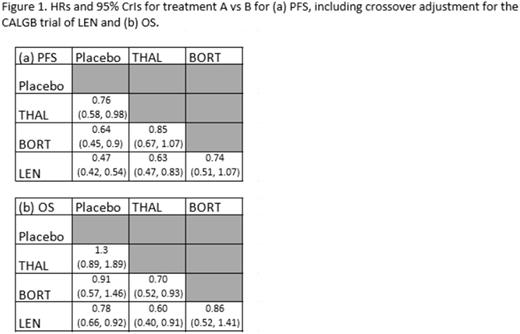Abstract
BACKGROUND
The European Society for Medical Oncology (ESMO) and the National Comprehensive Cancer Network (NCCN) guidelines recommend maintenance treatment for patients with newly diagnosed multiple myeloma (NDMM) post-autologous stem cell transplant (ASCT). The US Food and Drug Administration and European Medicines Agency granted approval for lenalidomide (LEN) as maintenance treatment in 2017. Given the high unmet need and the previous absence of a licensed treatment, other agents, including bortezomib (BORT) and thalidomide (THAL), have also been studied for maintenance treatment as discussed in ESMO and NCCN guidelines. The objective of this analysis was to investigate the relative effectiveness of LEN, THAL, and BORT monotherapies as maintenance treatment in patients with NDMM post-ASCT.
METHODS
Medline, Embase, Cochrane, Web of Science, and the grey literature were searched in September 2016 (with no start date limit) for randomised controlled trials (RCTs) that examined the effect of maintenance treatment in patients with NDMM post-ASCT. Trials that recruited transplant-ineligible patients were also included, as long as outcomes data for the transplant-eligible subgroups were available. Patients had to have achieved stable disease following ASCT prior to initiation of maintenance treatment. Outcomes of interest were progression-free survival (PFS), event-free survival or time to progression (used in the absence of PFS), and overall survival (OS). Outcomes from the most mature published data, such as European Public Assessment Reports, were incorporated when available. A Bayesian network meta-analysis (NMA) using non-informative prior distributions and assuming fixed effects (due to the limited number of trials) was fitted to evaluate the relative effect of maintenance treatment on outcomes. The model estimated the relative efficacy for each pairwise comparison, measured as hazard ratios (HRs), with uncertainty captured as 95% credible intervals (CrIs), assuming an exponential survival model applied to median PFS/OS and/or survival rate data with patient numbers if median had not been reached. The NMA included, when available, analyses using outcomes adjusted for crossover. Sensitivity analyses were carried out, including and excluding trials with significant risk of bias.
RESULTS
Seven RCTs with 3113 patients with post-ASCT NDMM were included (1056 LEN, 302 BORT, 528 THAL, 1227 no treatment/placebo). Pairwise comparisons for each outcome were estimated in the analysis. For PFS, all active treatments had superior outcomes to no maintenance/placebo, with LEN being the most effective treatment (HR, 0.47 [95% CrI, 0.42-0.54]) (Figure 1a). For OS, LEN was the most effective treatment (HR, 0.78 [95% CrI, 0.66-0.92]) (Figure 1b).
Use of active maintenance treatment consistently improved PFS for patients with post-ASCT NDMM. Except for LEN, results with other agents were less consistent for OS. THAL appeared to be less effective than no maintenance for OS, although this finding was non-significant. Limitations of the analysis include different OS follow-up time points across trials and other heterogeneity, including different patient baseline characteristics, use of different induction regimens, and use of different regimens following progression. The results for LEN maintenance vs no treatment in this NMA are consistent with those of a recent meta-analysis (McCarthy et al. J Clin Oncol 2017). The small differences in the estimates can be attributed to different methodology, with McCarthy et al analysing patient-level data from 3 trials and this analysis being based on aggregate outcomes from different time points but providing for greater consideration of uncertainty.
CONCLUSION
This NMA is the first to assess relative efficacy of LEN vs other active therapies as post-ASCT maintenance treatment in patients with NDMM. The superior outcomes of LEN over no maintenance and other active therapies further support its use as maintenance treatment in this patient population and provides an important evidence base for health technology assessment and/or clinical decision-making.
Schmitz: Celgene: Consultancy. Buchanan: Celgene: Consultancy. Dhanasiri: Celgene Corporation: Employment, Equity Ownership. Pawlyn: Takeda: Honoraria, Other: Travel support; Janssen: Other: Travel support; Celgene: Honoraria, Other: Travel support. Ashcroft: Celgene: Consultancy, Honoraria, Speakers Bureau; Amgen: Honoraria, Speakers Bureau; Janssen: Consultancy, Honoraria, Speakers Bureau; Takeda: Consultancy, Honoraria, Speakers Bureau.
Author notes
Asterisk with author names denotes non-ASH members.


This feature is available to Subscribers Only
Sign In or Create an Account Close Modal